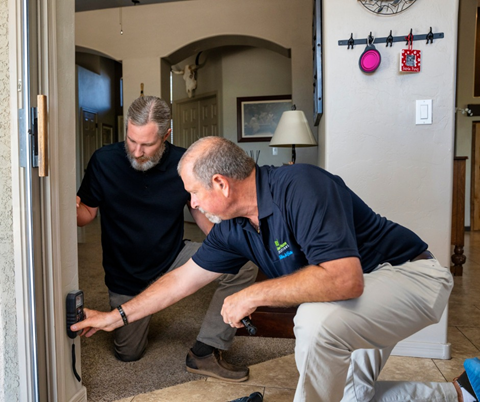Mycotoxin testing Services: A Secret Component in Risk Management Strategies
Mycotoxin testing Services: A Secret Component in Risk Management Strategies
Blog Article
Why Mycotoxin Testing Providers Are Vital for Protecting Public Wellness
The significance of mycotoxin screening solutions in safeguarding public health can not be overemphasized. Mycotoxins, harmful substances created by fungi, posture severe health threats such as liver damage and cancer cells when present in food and feed.
Recognizing Mycotoxins
Understanding mycotoxins is critical for making sure food safety and shielding public health and wellness. Mycotoxins are toxic substances produced by particular types of fungis, frequently found in food and feed plants.
The presence of mycotoxins in foods can compromise their security and quality. They are immune to conventional food handling strategies, thus continuing the food supply chain and presenting possible dangers. Regulatory bodies worldwide, such as the Food and Agriculture Company (FAO) and the Globe Health Company (WHO), have actually established rigid restrictions on appropriate levels of mycotoxins in foodstuff to reduce their unfavorable effects.
Reliable mycotoxin monitoring entails detailed monitoring and screening to discover and quantify their degrees in agricultural items. This positive method helps in recognizing contaminated sets early, thus preventing their intro into the market. Applying rigorous mycotoxin controls is crucial for preserving food security requirements and safeguarding customer health and wellness.
Health Dangers of Mycotoxins

Exposure to mycotoxins postures considerable health threats to both animals and human beings, requiring cautious tracking and control measures. In people, mycotoxins such as ochratoxins, fumonisins, and aflatoxins can cause a variety of adverse effects, consisting of liver damage, kidney poisoning, immune reductions, and also cancer causing effects.

Provided these severe health effects, it is imperative to apply durable mycotoxin testing methods. Precise detection and quantification of mycotoxins in food and feed are important to minimize wellness threats and make sure animal and public safety.
Typical Resources of Contamination

In addition to grains, nuts such as almonds, peanuts, and pistachios are very vulnerable to mycotoxin contamination. Aflatoxins, a potent type of mycotoxin, are generally found in these nuts, specifically when storage problems are suboptimal. Dried fruits, including raisins, apricots, and figs, likewise existing abundant grounds for fungal development due to their high sugar web content and moisture-retaining buildings.
Additionally, contamination is not restricted to raw farming products. Processed foods, pet feeds, and milk items can likewise include mycotoxins if the initial active ingredients were contaminated. This expands the risk of exposure throughout the food supply browse around this site chain, demanding strict tracking and control actions.
Understanding the usual sources of mycotoxin contamination is important for applying effective preventative techniques. Alleviating these threats at the resource can significantly decrease the incidence of mycotoxin-related health and wellness concerns, guarding public health.
Checking Methods and Protocols
Advanced analytical techniques are used to identify and evaluate mycotoxins in numerous substrates, guaranteeing public health safety and security. High-Performance Fluid Chromatography (HPLC) combined with mass spectrometry (MS) is a gold standard in mycotoxin screening, providing high sensitivity and uniqueness.
One more commonly used approach is Enzyme-Linked Immunosorbent Assay (ELISA), which uses fast screening and is cost-efficient for huge example volumes - Mycotoxin testing Services. ELISA sets are beneficial due to their convenience of use and quick turnaround time, making them ideal for on-site testing
Sampling methods are similarly important. Proper tasting guarantees that the collected samplings are representative of the whole set, thereby reducing the risk of incorrect negatives or positives. Adherence to developed standards, such as those supplied by the International Organization for Standardization (ISO) and the European Committee for Standardization (CEN), is vital for preserving uniformity and integrity throughout screening methods.
Strenuous validation of these approaches and procedures is important. It ensures reproducibility and precision, thus strengthening the honesty of mycotoxin management systems.

Advantages of Routine Checking
In the realm of food security and agricultural top quality control, the advantages of regular mycotoxin testing can not be overstated. Constant testing ensures that agricultural items satisfy security requirements, thereby protecting consumers from the harmful results of mycotoxins, which consist of liver damages, immune reductions, and also cancer cells. By determining polluted sets early, routine testing permits for prompt intervention, preventing such products from getting in the food web.
Furthermore, routine mycotoxin testing is essential for keeping the integrity and track record of food producers and suppliers. Companies that devote to regular testing show their devotion to public wellness and food safety, thereby gaining consumer depend on and loyalty. This proactive technique can also reduce monetary losses related to item recalls, legal obligations, and possible profession constraints.
Normal mycotoxin screening guarantees adherence to nationwide and worldwide standards, promoting smooth trade procedures and market accessibility. Ultimately, regular mycotoxin testing not only protects public health but also fortifies the financial security and worldwide competitiveness of the agricultural sector.
Verdict
Mycotoxin screening services play an important function in public health defense by determining and alleviating the risks postured by hazardous fungal compounds in food and feed. By spotting contamination early, these services protect against significant wellness problems such as liver damage and cancer, ensuring conformity with governing requirements. Regular screening boosts customer count on, supports the look these up integrity of get more the farming industry, and ultimately adds to the guarding of food safety and public health.
The significance of mycotoxin testing solutions in safeguarding public wellness can not be overstated.Understanding mycotoxins is crucial for ensuring food safety and safeguarding public health and wellness. Mycotoxin testing Services. Regulative bodies worldwide, such as the Food and Agriculture Company (FAO) and the Globe Health Company (THAT), have actually established rigorous restrictions on acceptable degrees of mycotoxins in food items to reduce their negative effects
Ultimately, routine mycotoxin screening not just safeguards public health and wellness yet also fortifies the economic security and international competition of the agricultural industry.
Mycotoxin testing solutions play an essential role in public health and wellness security by recognizing and mitigating the risks positioned by hazardous fungal substances in food and feed.
Report this page